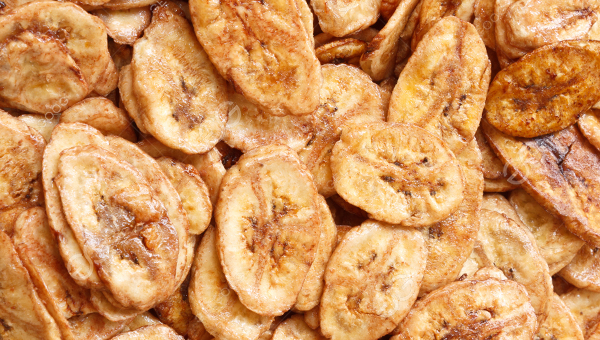As a popular snack food, the procedure for making plantain chips requires multiple steps, including peeling, slicing, blanching, frying, and degreasing.

Peeling
plantains need to be washed before peeling to remove impurities on the surface. When peeling, try to avoid too much air contact with the plantain pulp to prevent oxidation and discoloration. Using special peeling equipment can improve peeling efficiency and product quality.
Slicing
The peeled plantains need to be sliced. The thickness of the slices is generally controlled at 3-5 mm. Too thick will result in poor frying effect, while too thin will make the taste worse. When slicing, an automatic slicer can be used to ensure uniform slice thickness, thereby ensuring consistency in subsequent processing.
Blanching
Blanching means briefly heating the plantain slices in hot water to remove enzyme activity and prevent browning. The blanching temperature is generally 85-90°C and the time is 2-3 minutes. After blanching, the plantain slices need to be cooled quickly to avoid overheating and softening the texture.
Frying
Frying is one of the key steps in the production of plantain chips. The temperature and time of frying directly affect the taste, color and texture of plantain chips.
Oil temperature control: Usually, the frying temperature is controlled at 160-180°C. If the oil temperature is too low, the plantain chips will absorb too much oil, resulting in a greasy product; if the temperature is too high, the surface of the plantain chips will quickly burn, affecting the taste and appearance.
Frying time: The frying time is generally controlled at 2-3 minutes, and the specific time is adjusted according to the thickness of the slices and the equipment used. If the time is too short, the inside of the plantain chips may not be completely dehydrated, resulting in a soft taste; if the time is too long, it is easy to make the plantain chips bitter.
Deoiling
Deoiling is an important step immediately after frying. Its purpose is to remove excess oil to improve the taste of plantain chips, reduce greasiness, and extend the shelf life. The effect of deoiling directly affects the crispness and taste of the product.
Centrifugal deoiling: Use a centrifugal deoiler to spin at high speed to remove excess oil. This method can quickly and effectively remove surface oil.
Vacuum deoiling: Compared with centrifugal deoiling, vacuum deoiling is carried out at a lower temperature, which can further reduce the oil content and retain the natural flavor and crispness of plantain chips.
Good technology can make plantain chips crispy and delicious, improve taste and shelf life. If you are interested in plantain chips production equipment, please contact us.